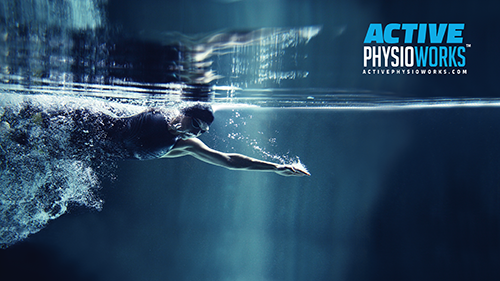Swimmer's Shoulder Injury Prevention
Feb 12, 2019
Whether you are training for your first triathlon, mastering your 100 metre swim time or are simply trying to stay active, it is important to be aware of the potential shoulder injuries that can arise. Over one third of swimmers experience some type of shoulder pain in their swimming career, and one of the most common swimming injuries is called “subacromial impingement”, aka “swimmer’s shoulder”.
Why it happens:
Swimming requires repetitive overhead movement patterns and the resistance of the water places a lot of load through the shoulder joints.
Compared to the hip, the shoulder is an extremely mobile joint and relies on surrounding ligaments and muscles for stability and control. If these muscles and ligaments become overworked from overtraining, weakness, tightness or hyper mobility, this can lead to injury.
How to prevent it
Fortunately, swimming shoulder injuries are preventable, and are most commonly caused by poor swimming techniques and weakness through the shoulder joint. Here are some helpful tips for prevention:
- Warm up! The start of your workout should include an easy gradual 10-20 minute warmup to increase blood flow, heart rate and warm up the joints before starting your main set.
- Improve your stroke mechanics.
a. Bend your elbow when pulling through the water. A fully extended elbow (straight arm) during the stroke places too much strain on the rotator cuff and can lead to overuse injuries.
b. Lead with fingers not thumb. Entering the water with the thumb instead of your fingers can lead to increased internal rotation in the shoulder joint and cause impingement.
c. Do not cross mid-line: During the ‘catch and pull’ phase of your swim, the hand and arm should enter the water in-line with the shoulder. If the hand enters more towards the mid-line it places stress through the shoulder joint and its surrounding muscles. - Improve thoracic spine (mid-back) mobility. The thoracic spine plays a very important role in the breathing aspect of your front crawl. With limited rotation throughout the thoracic spine, it causes your hips to over-rotate and your shoulders and chest to roll forwards. One of my favorite thoracic spine mobilization techniques is lying horizontally along a foam roller, which we sell at all of our clinic locations.
- Dry-land strength train. Start doing weekly scapular stabilizing and rotator cuff exercises to increase strength and help you become a more powerful and efficient swimmer.
If you are still experiencing nagging shoulder pain, and are uncertain where to go from here, a physiotherapist, doctor and/or swimming coach may be required to identify the cause of the problem and help to rehabilitate you back to health.
Happy Swimming!

Bak, K. Nontraumatic glenohumeral instability and coracoacromial impingement in swimmer. Scand J Med Sci Sports. 1996;6 132-144
Tovin, B. (2006) “Prevention and Treatment of Swimmer’s Shoulder.” North American Journal of Sport Physical Therapy. Nov; 1 (4): 166-175.
Please add your bio info through your member profile page, or through your dashboard.

